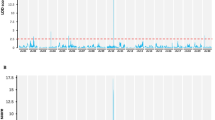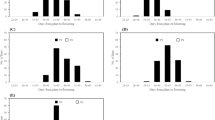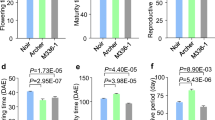Abstract
Soybean is a quantitative photoperiod sensitive short-day crop. In Asian countries, soybean is grown under rain-fed conditions. However, late planting due to delayed onset of the rainy season results in the reduced biomass leading to considerable yield losses. Long juvenility (LJ) trait in soybean delays flowering and helps in gaining biomass under short days. Our objective of this work was to understand the molecular basis of long juvenility in a genetic resource AGS 25. In this study, we used recombinant inbred lines (RILs) developed from an LJ genotype AGS 25 and conventional juvenile (CJ) genotype JS 93–05 and mapped a major quantitative trait locus (QTL) explaining upto 39.7% of the phenotypic variation. The identified QTL carried two candidate flowering genes FT2a and FT2b, in which genomic DNA sequencing of coding DNA sequence identified the former with a functional SNP variation but the latter was found monomorphic. The identified mutation in FT2a could be associated with LJ and validated in another segregating population (F2 of SL 958 × AGS 25). The novel mutation caused a non-synonymous substitution of conserved glycine with aspartic acid (G169D) and the mechanism of LJ through this mutation is to be further divulged. This identified mis-sense mutation found associated with delayed flowering in two previous reports. The identified new functional SNP created differential HinfI (e9-CAPS) restriction sites and high-resolution melt (HRM) profiles (e9-HRM) for CJ and LJ parents and are associated with delayed flowering in RILs and F2 population (SL 958 × AGS 25).




Similar content being viewed by others
Availability of data and materials
All data generated or analyzed during this study are included in this published article and its supplementary information files.
References
Ahn JH, Miller D, Winter VJ, Banfield MJ, Lee JH et al (2006) A divergent external loop confers antagonistic activity on floral regulators FT and TFL1. EMBO J 25:605–614
Anonymous: Annual Report 2013–2014. Directorate of Soybean Research Indore
Bernard RL (1971) Two major genes for time of flowering and in soybeans. Crop Sci 11:242–244. https://doi.org/10.2135/cropsci.0011183X001100020022x
Böhlenius H, Huang T, Charbonnel-Campaa L, Brunner AM, Jansson S, Strauss SH, Nilsson O (2006) CO/FT regulatory module controls timing of flowering and seasonal growth cessation in trees. Science 312:1040–1043
Bonato ER, Vello NA (1999) E6 a dominant gene conditioning early flowering and in soybeans. Genet Mol Biol 22:229–232. https://doi.org/10.1590/S1415-47571999000200016
Buzzell RI (1971) Inheritance of a soybean flowering response to fluorescent day length conditions. Can J Genet Cytol 13:703–707. https://doi.org/10.1139/g71-100
Buzzell RI, Voldeng HD (1980) Inheritance of insensitivity to long day length. SoybeanGenet Newsl 7:26–29. https://doi.org/10.1093/jhered/esp113
Cai Y, Chen L, Liu X, Guo C, Sun S, Wu C, Jiang B, Han T, Hou W (2018) CRISPR/Cas9-mediated targeted mutagenesis of GmFT2a delays flowering time in soya bean. Plant Biotechnol J 16:176–185
Cai Y, Wang L, Chen L, Wu T, Liu L, Sun S, Wu C, Yao W, Jiang B, Yuan S, Han T, Hou W (2019) Mutagenesis of GmFT2a and GmFT5a mediated by CRISPR/Cas9 contributes for expanding the regional adaptability of soybean. Plant Biotechnol J. https://doi.org/10.1111/pbi.13199
Cao Y, Li S, He X, Chang F, Kong J, Gai J, Zhao T (2017) Mapping QTLs for plant height and flowering time in a Chinese summer planting soybean RIL population. Euphytica 213:39. https://doi.org/10.1007/s10681-016-1834-8
Chen L, Cai Y, Liu X et al (2018) Improvement of Soybean Agrobacterium-Mediated Transformation Efficiency by Adding Glutamine and Asparagine into the Culture Media. Int J Mol Sci 19(10):3039
Cober ER (2011) Long juvenile soybean flowering responses under very short photoperiods. Crop Sci 51:140–145. https://doi.org/10.2135/cropsci2010.05.0262
Cober ER, Voldeng HD (2001) A new soybean and photoperiod-sensitivity locus linked to E1 and T. Crop Sci 41:698–701. https://doi.org/10.2135/cropsci2001.413698x
Cober ER, Molnar SJ, Charette M, Voldeng HD (2010) A new locus for early in soybean. Crop Sci 50:524–527. https://doi.org/10.2135/cropsci2009.04.0174
Corbesier L, Coupland G (2006) The quest for florigen: a review of recent progress. J Exp Bot 57:3395–3403
Corbesier L, Vincent C, Jang S, Fornara F, Fan Q, Searle I, Giakountis A, Farrona GL, Turnbull C, Coupland G (2007) FT protein movement contributes to long distance signaling in floral induction of Arabidopsis. Science 316:1030–1033
Doyle JJ, Doyle JL (1990) Isolation of plant DNA from fresh tissue. Focus 12:13–15
Gavioli (2013) Explanations for the Rise of Soybean in Brazil. In A Comprehensive Survey of International Soybean Research - Genetics, Physiology, Agronomy and Nitrogen Relationships", book edited by James E. Board, 2013, ISBN 978–953–51–0876–4under CC BY 3.0 license.
Gupta S, Bhatia VS, Kumawat G, Thakur D, Singh G, Tripathi R, Satpute G, Devdas R, Husain SM, Chand S (2017) Genetic analysis for deciphering the status and role of photoperiodic and genes in major Indian soybean cultivar. J Gen 1:147–154
Hartwig EE (1970) Growth and reproductive characteristics of soybean [Glycinemax (L.) Merr.] grown under short-day conditions. Crop Sci 12:47–53
Hartwig EE, Kiihl RAS (1979) Identification and utilization of a delayed flowering character in soybean for short-day conditions. Field Crops Res 2(2):145–151. https://doi.org/10.1016/0378-4290(79)90017-0
Hayama R, Yokoi S, Tamaki S, Yano M, Shimamoto K (2003) Adaptation of photoperiodic control pathways produces short-day flowering in rice. Nature 422:719–722
Hicks KA, Albertson TA, Meeks-Wagner DR (2001) Early Flowering 3 encodes a novel protein that regulates circadian clock function and flowering in Arabidopsis. Plant Cell 13:1281–1292
Hsu CY, Liu Y, Luthe DS, Yuceer C (2006) Poplar FT2 shortens the juvenile phase and promotes seasonal flowering. Plant Cell 18:1846–1861
Izawa T, Oikawa T, Sugiyama N, Tanisaka T, Yano M, Shimamoto K (2002) Phytochrome mediates the external light signal to repress FT orthologs in photoperiodic flowering of rice. Genes Dev 16:2006–2020
Jaeger KE, Wigge PA (2007) FT protein acts as a long range signal in Arabidopsis. Curr Biol 17:1050–1054
Jiang K, Liberatore KL, Park SJ, Alvarez JP, Lippman ZB (2013) Tomato yield heterosis is triggered by a dosage sensitivity of the florigen pathway that fine-tunes shoot architecture. PLoS Genet 9:e1004043
Jiang B, Zhang S, Song W, Khan MAA, Sun S, Zhang C, Wu T, Wu C, Han T (2019) Natural variations of FT family genes in soybean. BMC Genomic 20:230
Kojima S, Takahashi Y, Kobayashi Y, Monna L, Sasaki T, Araki T, Yano M (2002) Hd3a, a rice ortholog of the Arabidopsis FT gene, promotes transition to flowering downstream of Hd1 under short-day conditions. Plant Cell Physiol 43:1096–1105
Kong F, Liu B, Xia Z, Sato S, Kim BM, Watanabe S, Yamada T, Tabata S, Kanazawa A, Harada K, Abe J (2010) Two coordinately regulated homologs of FLOWERING LOCUS T are involved in the control of photoperiodic flowering in soybean. Plant Physiol 154:1220–1231
Kong F, Nan H, Cao D, Li Y, Wu F, Wang J, Lu S, Yuan X, Abe J, Cober ER, Liu B (2014) A new dominant gene E9 conditions early flowering and maturity in soybean. Crop Sci 54:2529–2535. https://doi.org/10.2135/cropsci2014.03.0228
Kumawat G, Maranna S, Gupta S, et al (2020) Identification of novel genetic sources for agronomic and quality traits in soybean using multi-trait allele specific genic marker assays. J Plant Biochem Biotechnol. https://doi.org/10.1007/s13562-020-00580-x
Lawn RJ, James AT (2011a) Application of physiological understanding in soybean improvement. I. Understanding phenological constraints to adaptation and yield potential. Crop Pasture Sci 62:1–11. https://doi.org/10.1071/CP10289
Lawn RJ, James AT (2011b) Application of physiological understanding in soybean improvement. II. Broadening phenological adaptation across regions and sowing dates. Crop Pasture Sci 62:12–24
Li Y, Guan R, Liu Z, Ma Y, Wang L, Li L, Lin F, Luan W, Chen P, Yan Z, Guan Y, Zhu L, Ning X, Smulders MJN, Li W, Piao R, Cui Y, Yu Z, Guan M, Chang R, Hou A, Shi A, Zhang B, Zhu S, Qiu L (2008) Genetic structure and diversity of cultivated soybean (Glycine max (L.) Merr.) landraces in China. Theor Appl Genet 117:857–871. https://doi.org/10.1007/s00122-008-0825-0
Lifschitz E, Eviatar T, Rozman A, Shalit A, Goldshmidt A, Amsellem Z, Alvarez JP, Eshed Y (2006) The tomato FT ortholog triggers systemic signals that regulate growth and flowering and substitute for diverse environmental stimuli. Proc Natl Acad Sci USA 103:6398–6403
Liu B, Kanazawa A, Matsumura H, Takahashi R, Harada K, Abe J (2008) Genetic redundancy in soybean photoresponses associated with duplication of the phytochrome A gene. Genetics 180:995–1007. https://doi.org/10.1534/genetics.108.092742
Liu W, Jiang B, Ma L, Zhang S, Zhai H, Xu X et al (2018) Functional diversification of flowering locus T homologs in soybean: GmFT1a and GmFT2a/5a have opposite roles in controlling flowering and maturation. New Phytol 217(3):1335–1345. https://doi.org/10.1111/nph.14884
Lochlainn SÓ, Amoah S, Graham NS, Alamer K, Rios JJ, Kurup S, Stoute A, Hammond JP, Østergaard L, King GJ, White PJ, Broadley MR (2011) High Resolution Melt (HRM) analysis is an efficient tool to genotype EMS mutants in complex crop genomes. Plant Methods 7(1):43. https://doi.org/10.1186/1746-4811-7-43
Lu S, Zhao X, Hu Y, Liu S, Nan H, Li X, Fang C, Cao D, Shi X, Kong L, Su T, Zhang F, Li S, Wang Z, Yuan X, Cober ER, Weller JL, Liu B, Hou X, Tian Z, Kong F (2017) Natural variation at the soybean J locus improves adaptation to the tropics and enhance yield. Nature gen 49:773–779. https://doi.org/10.1038/ng.3819
Mathieu J, Warthmann N, Küttner F, Schmid M (2007) Export of FT protein from phloem companion cells is sufficient for floral induction in Arabidopsis. Curr Biol 17:1055–1060
Matsubara K, Ogiso-Tanaka E, Hori K, Ebana K, Ando T, Yano M (2012) Natural variation in Hd17, a homolog of Arabidopsis ELF3 that is involved in rice photoperiod flowering. Plant Cell Physiol 53:709–716. https://doi.org/10.1093/pcp/pcs028
Meng L, Huihui L, Zhang L, Wang J (2015) QTL ICI Mapping: Integrated Software genetic Linkage Map construction and Quantitative trait locus mapping in biparental populations. The Crop J 3:269–283. https://doi.org/10.1016/j.cj.2015.01.001
Michelmore RW, Paran I, Kesseli RV (1991) Identification of markers linked to disease resistance genes by bulked segregant analysis: A rapid method to detect markers in specific genome regions by using segregating populations. Proc Natl Acad Sci USA 88:9828–9832
Nan H, Cao D, Zhang D, Li Y, Lu S, Tang L, Yuan X, Liu B, Kong F (2014) GmFT2a and GmFT5aredundantly and differentially regulate flowering through interaction with and upregulation of the bZIP transcription factor GmFDL19 in soybean. PLoS ONE 9:e97669
Neff MM, Turk E, Kalishman M (2002) Web-based primer design for single nucleotide polymorphism analysis. Trends Genet 18:613–615
Notaguchi M, Abe M, Kimura T, Daimon Y, Kobayashi T, Yamaguchi A, Tomita Y, Dohi K, Mori M, Araki T (2008) Long distance, graft transmissible action of Arabidopsis FLOWERING LOCUS T protein to promote flowering. Plant Cell Physiol 49:1645–1658
Ogiso-Tanaka E, Shimizu T, Hajika M, Kaga A, Ishimoto M (2019) Highly multiplexed AmpliSeq technology identifies novel variation of flowering time-related genes in soybean (Glycine max). DNA Res 26(3):243–260. https://doi.org/10.1093/dnares/dsz005
Parvez AQ, Gardner FP (1987) Daylength and sowing date responses of soybean lines with “juvenile” trait. Crop Sci. 27:305–310. https://doi.org/10.2135/cropsci1987.0011183X002700020037x
Ray JD, Hinson K, Mankono JEB, Malo MF (1995) Genetic control of a long-juvenile trait in soybean. Crop Sci. 35:1001–1006. https://doi.org/10.2135/cropsci1995.0011183X003500040012x
Sinclair TR, Hinson K (1992) Soybean flowering in response to the long juvenile trait. Crop Sci 32:1242–1248. https://doi.org/10.2135/cropsci1992.0011183X003200050036x
Song Q, Jia G, Zhu Y, Grant D, Nelson RT, Hwang EY, Hyten DL, Cregan PB (2012) Abundance of SSR motifs and development of candidate polymorphic SSR markers (BARCSOYSSR_1.0) in Soybean. Crop Sci. 50:1950–1960. https://doi.org/10.2135/cropsci2009.10.0607
Sun H, Jia Z, Cao D, Jiang B, Wu C, Hou W, Liu Y, Fei Z, Zhao D, Han T (2011) GmFT2a, a soybean homolog of FLOWERING LOCUS T, is involved in flowering transition and maintenance. PLoS ONE 6:e29238
Sun F, Xu M, Park C, Dwiyanti MS, Nagano AJ, Zhu J et al (2019) Characterization and quantitative trait locus mapping of lateflowering from a Thai soybean cultivar introduced into a photoperiod-insensitive genetic background. PLoS ONE 14(12):e0226116
Turck F, Fornara F, Coupland G (2008) Regulation and identity of florigen: FLOWERING LOCUS T moves center stage. Annu Rev Plant Biol 59:573–594
Untergasser A, Cutcutache I, Koressaar T, Ye J, Faircloth BC, Remm M, Rozen SG (2012) Primer3 new capabilities and interfaces. Nucleic Acids Res. 40(15):e115
Wang Z, Zhou Z, Liu Y, Liu T, Li Q, Ji Y, Li C, Fang C, Wang M, Wu M, Shen Y, Tang T, Ma J, Tian Z (2015) Functional evolution of phosphatidylethanolamine binding proteins in soybean and Arabidopsis. Plant Cell 27:323–336
Watanabe S, Hideshima R, Xia Z, Tsubokura Y, Sato S, Nakamoto Y, Yamanaka N, Takahashi R, Ishimoto M, Anai T, Tabata S, Harada K (2009) Map-based cloning of the gene associated with the soybean maturity locus E3. Genetics 182:1251–1262. https://doi.org/10.1534/genetics.108.098772
Watanabe S, Xia Z, Hideshima R, Tsubokura Y, Sato S, Harada K (2011) A map-based cloning strategy employing a residual heterozygous line reveals that the GIGANTEA gene is involved in soybean maturity and flowering. Genetics 188:395–407. https://doi.org/10.1534/genetics.110.125062
Watanabe S, Harada K, Abe J (2012) Genetic and molecular bases of photoperiod responses of flowering in soybean. Breed Sci 61:531–543. https://doi.org/10.1270/jsbbs.61.531
Weller JL, Liew LC, Hecht VF, Rajandran V, Laurie RE, Ridge S, Wenden B, Vander Schoor JK, Jaminon O, Blassiau C, Dalmais M, Rameau C, Bendahmane A, Macknight RC, Lejeune-Hénaut I (2012) A conserved molecular basis for photoperiod adaptation in two temperate legumes. Proc Natl Acad Sci USA 109:21158–21163. https://doi.org/10.1073/pnas.1207943110
Xia Z, Watanabe S, Yamada T, Tsubokura Y, Nakashima H, Zhai H, Anai T, Sato S, Yamazaki T, Lu S, Wu H, Tabata K, Harada K (2012) Positional cloning and characterization reveal the molecular basis for soybean maturity locus E1 that regulates photoperiodic flowering. Proc Natl Acad Sci USA 109:E2155–E2164. https://doi.org/10.1073/pnas.1117982109
Xu M, Xu Z, Liu B, Kong F, Tsubokura Y, Watanabe S, Xia Z, Harada K, Kanazawa A, Yamada T, Abe J (2013) Genetic variation in four maturity genes affects photoperiod insensitivity and PHYA-regulated post-flowering responses of soybean. BMC Plant Biol 13:91. https://doi.org/10.1186/1471-2229-13-91
Yan L, Fu D, Li C, Blechl A, Tranquilli G, Bonafede M, Sanchez A, Valarik M, Yasuda S, Dubcovsky J (2006) The wheat and barley vernalization gene VRN3 is an orthologue of FT. Proc Natl Acad Sci USA 103:19581–19586
Zhai H, Lü S, Liang S, Wu H, Zhang X et al (2014) GmFT4, a homolog of flowering locus T, Is positively regulated by E1 and functions as a flowering repressor in soybean. PLoS ONE 9(2):e89030
Zhao C, Takeshima R, Zhu J, Xu M, Sato M, Watanabe S, Kanazawa A, Liu B, Kong F, Yamada T, Abe J (2016) A recessive allele for delayed flowering at the soybean maturity locus E9 is a leaky allele of FT2a, a flowering locus T ortholog. BMC Plant Biol 16:20. https://doi.org/10.1186/s12870-016-0704-9
Acknowledgements
Authors are thankful to Director, ICAR-IISR, Indore for providing all the required facilities for the experiments.
Funding
The research was supported by grant from Department of Biotechnology, Ministry of science and technology, Government of India through Department of Biotechnology project number “BT/PR15159/AGIII/103/919/2016”.
Author information
Authors and Affiliations
Contributions
SG identified AGS 25, developed RILs, planned all experiments and coordinated the work; RT and NA performed phenotyping and genotyping of RILs; GK and MR analyzed molecular data and conducted MassArray of soybean germplasm; VB, SM, GKS, SC and MJ contributed in inheritance studies and phenotyping; PV conducted RIL phenotyping in Pune.
Corresponding author
Ethics declarations
Conflict of interest
The authors declare that they have no competing interests.
Additional information
Publisher's Note
Springer Nature remains neutral with regard to jurisdictional claims in published maps and institutional affiliations.
Supplementary Information
Below is the link to the electronic supplementary material.

Rights and permissions
About this article
Cite this article
Tripathi, R., Agrawal, N., Kumawat, G. et al. QTL mapping for long juvenile trait in soybean accession AGS 25 identifies association between a functional allele of FT2a and delayed flowering. Euphytica 217, 36 (2021). https://doi.org/10.1007/s10681-021-02775-2
Received:
Accepted:
Published:
DOI: https://doi.org/10.1007/s10681-021-02775-2




